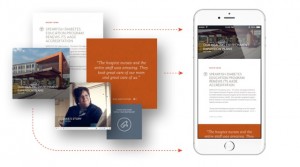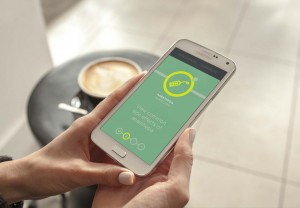Alexa, Find Me a Doctor
// By Shawn Gross //
 The robotic yet charming voice of Alexa can help you find a good movie, make a payment on your credit card, get airline fares for a trip to Dublin, or see how many calories are in the banana you’re eating. With an estimated 11 million devices sold, the Amazon Echo is quickly becoming a trend for innovative customer experience (CX). And healthcare is no exception. Mount Sinai is using Alexa to help patients find a doctor. Boston Children’s Hospital is using it to provide fever and medication advice.
The robotic yet charming voice of Alexa can help you find a good movie, make a payment on your credit card, get airline fares for a trip to Dublin, or see how many calories are in the banana you’re eating. With an estimated 11 million devices sold, the Amazon Echo is quickly becoming a trend for innovative customer experience (CX). And healthcare is no exception. Mount Sinai is using Alexa to help patients find a doctor. Boston Children’s Hospital is using it to provide fever and medication advice.
So how do you know if an Alexa app—or some other experience—is the right investment? Here’s what we know: Customers who have the best experiences are more loyal—and valuable.
According to a recent Harvard Business Review study “The New Science of Customer Emotions“, the most emotionally engaged customers are:
- At least three times more likely to make recommendations to their friends and family
- Three times more likely to repurchase
- Less likely to shop around
- Much less price sensitive
But what does it really mean to engage a customer emotionally? And which customer experiences are critical for building patient loyalty for your hospital?
Luckily there’s a science to it.
It starts with understanding the role of trust in consumer preference and decision-making. Neuroscience tells us that, within milliseconds of being exposed to a message, our brain’s amygdala determines if it is something we can trust or not. If it triggers negative memories, the amygdala sends out neurotransmitters that actually block the message from reaching the prefrontal cortex—the part of the brain that drives decision-making. In other words, a distrustful past experience can cloud a person’s future decisions and behavior—such as selecting a hospital or adhering to a doctor’s recommended treatment.
Neuroscience further reveals how the brain evaluates memories to determine trust. There are three factors in particular that we see in the most effective customer experiences today.
CX Trust Lever #1: Personal Connection
When evaluating trust in an individual or brand, the amygdala is trying to decide if the person is likely to act with your best interest in mind. It’s why friends and family are such strong influencers. They know us, therefore we trust that they know what we need.
It’s also why Stitch Fix has exploded in a challenging retail industry. Its model is built on the concept of sending clothing once a month that fits your style. As you select and return items each month, your personal stylist learns more about you and the selections get better and better—making you ever more loyal. With brands like Stitch Fix taking off, consumers now expect brands to be continually learning and adjusting their brand behavior accordingly.
In healthcare, personalization is a buzzword, but it requires much more than simply slapping someone’s name at the top of an email. We need to facilitate customer experiences that reflect an understanding of a patient’s needs and preferences. Brands like Regional Health have started to move in this direction with card-based websites that dynamically serve up web content according to a user’s past search history. As interoperability between the EHR, CRM, and website CMS improve, we’ll soon see hospital websites where every visitor receives a different experience. It will feel completely tailored to each visitor’s unique needs and preferences.
CX Trust Lever #2: Managing Expectations
Over-promise and under-deliver: When people expect one thing and experience something different, they lose trust in your ability to deliver on what you say in the future. It can take as many as 12 good experiences to make up for one bad experience, so it’s important to manage customer expectations and avoid distrust.
Consider how Amazon manages expectations by sending a push notification when your package ships. Or how the Domino’s Pizza Tracker can tell you if your pizza has been baked, is in the box, or is out for delivery. Even Uber shows you exactly where your driver is and how long you should expect it to take. Interestingly, the expectation that is set is not as important as the way it is communicated. Even if your Uber is late, you can see that it’s not far away and that it’s probably stuck in traffic. By managing your expectations, Uber has turned a potentially distrustful experience into a neutral or even positive one.
Hospitals also look at ways to set customer expectations. Today, many serve up ER wait times on their website home page. It’s not long before other apps follow. Like knowing whether your blood test is in the lab, being cultured, or the results have been sent to your doctor. Or being able to see if a loved one is in anesthesia, actively in surgery, or in recovery.
There are also simple things hospitals can do to manage patient expectations and avoid distrust. For example, when patients submit a contact form on your website, do you tell them it might take up to 48 hours to respond? Or do you let them assume you’ll call them back in an hour and risk creating distrust when it doesn’t happen?
CX Trust Lever #3: Shared Vision
Neuroscience also shows that when people feel included in the planning process and see things the same way you see them, they have a greater sense of trust.
Consider how the financial industry effectively engages consumers around 401(k) planning. Online calculators ask about a user’s lifestyle, risk tolerance, and hopes for the future. Then it presents a plan customized to those preferences. Rather than just trying to tell someone it’s important to save money now, these tools include users in the process—creating a shared vision of their retirement future and greater trust in the importance of investing today.
There are striking similarities between 401(k) planning and motivating patients in healthcare. In both cases, you can’t truly appreciate the value until much later in the future. Digital experiences can create a shared vision to engage consumers today.
Take quality and safety data, for example. Ochsner Health System engages consumers around this data in new ways—asking users to share their preferences and serving up a personalized quality report. “Like 401(k) planning where you can’t truly appreciate the value until 40 or 50 years in the future, we don’t want our community to be researching quality and safety data when they are too sick to evaluate it at all,” says Amber Welch, Ochsner’s director of digital content. Ochsner’s new online quality and safety experience lets users select which specialty they are most interested in and which measures of quality—from convenience to expertise to risks—are most important to them. Based on their selections, each user receives a dashboard of quality measures they might consider and how Ochsner stacks up.
Mapping the Micro-Moments of Consumer Trust
While Alexa may have a lot of answers, an Amazon Echo app may—or may not—be the answer for your digital strategy. The customer journey is made up of millions of opportunities to build positive memories and drive preference and loyalty. By mapping individual moments of trust, you can identify the most crucial ones to fuel your customer experience.
As Chief Digital Strategist at White Rhino, Shawn Gross helps leading healthcare brands map moments of trust and build digital strategies across the healthcare journey. To learn more about the science behind creating a more consumer-centric digital experience, see Shawn speak at HCIC October 23-25, 2017 in Austin, Texas.



